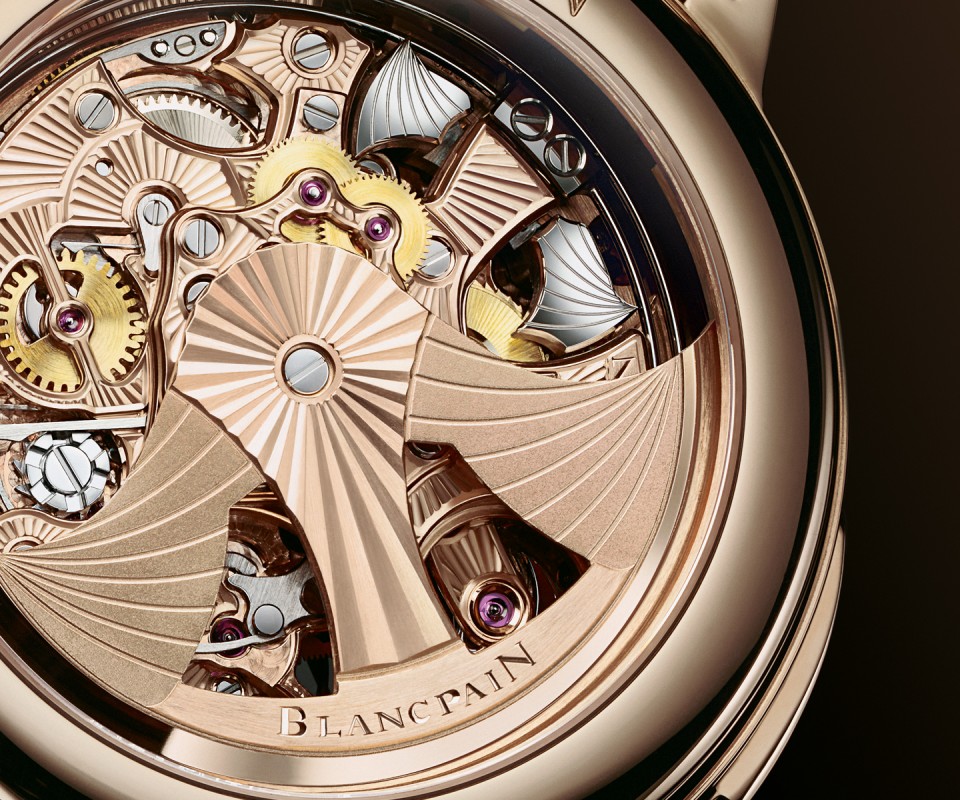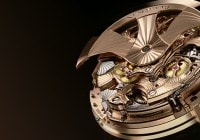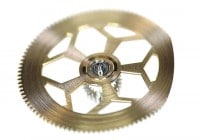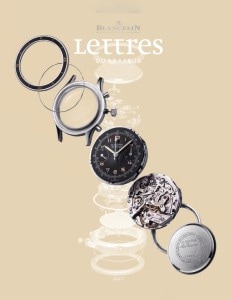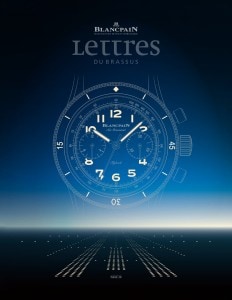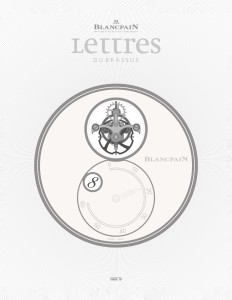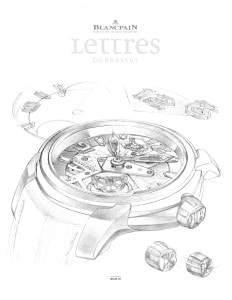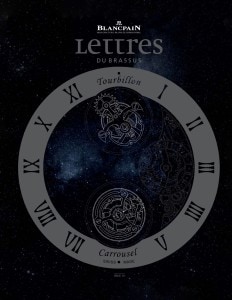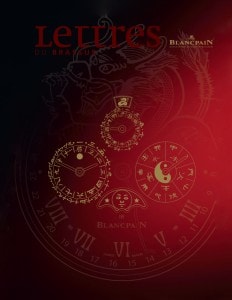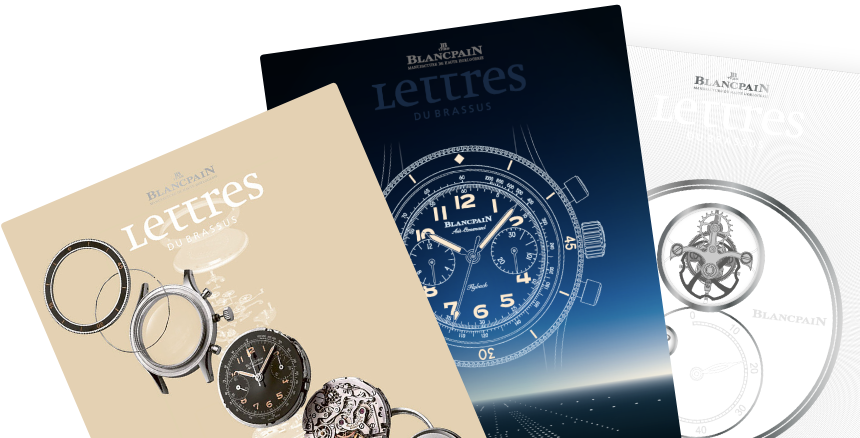
Search in Issues
Chapters
List of parts
Chapter 3
The Carrousel GRAND COMPLICATION
Entering the Pantheon of its grand complications is Blancpain’s new Le Brassus Carrousel Répétition Minutes Chronographe Flyback.

Blancpain is resolute in believing that A GRAND COMPLICATION must be innovative in all its dimensions.
A logical proposition. The creation of a grand complication timepiece, which by definition must off er a combination of complications, can occur in one of two ways. The first is the bringing together of classic complications, created in the usual ways, so that the “creativity” consists merely in assembling the package, so to speak. The second is bolder. Innovate around each of the complications and then innovate further in bringing them together. With the Le Brassus Carrousel Répétition Minutes Chronographe Flyback Blancpain has resolutely cast its lot in the latter camp. Each principal element of this grand complication watch stands on its own feet with true inventiveness and creativity in its category. And underscoring the innovations: never before has there been a wristwatch offering this unique combination of complications.
As it must be for any watch, the heart of Le Brassus Carrousel Répétition Minutes Chronographe Flyback is the central timekeeping element which in this case is the carrousel. Blancpain was the first to develop a carrousel for a wristwatch and, as we explain further in these pages 6-21 presenting the Tourbillon Carrousel, there were many world firsts that accompanied this achievement: the first flying carrousel in a wristwatch, the first one minute flying carrousel in any form of timepiece, the longest power reserve for any carrousel, and the fi rst carrousel with a centered balance wheel. Although the Le Brassus Carrousel Répétition Minutes Chronographe Flyback adheres to the basics of Blancpain’s record breaking design, subtle enhancements have been added. Blancpain’s original carrousel utilized a flat hairspring for the balance. In this new implementation the hairspring now has what is known as a “Breguet overcoil.” Th e overcoil is an invention originally developed by famed watchmaker Abraham-Louis Breguet in 1795. With standard flat construction, the inner end of the spiral is attached near the center axis of the balance wheel while the outer end is attached to an arm. With this arrangement it is impossible to achieve perfect concentricity and centering of a spiral as the outer portion of the spiral that is attached to the arm is not matched on the opposite side. Abraham-Louis Breguet discovered that if the outside portion of the hairspring’s coil were bent upward and inward over the main part of the coil
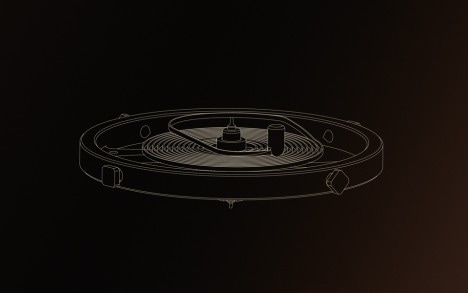
The balance wheel showing its Breguet overcoil spiral.
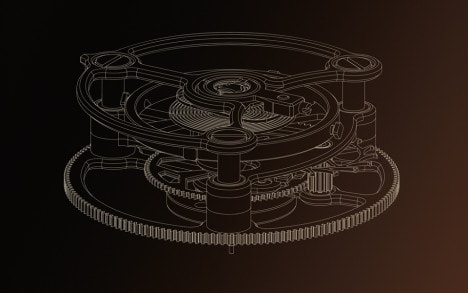
The carrousel cage, balance wheel and escapement.
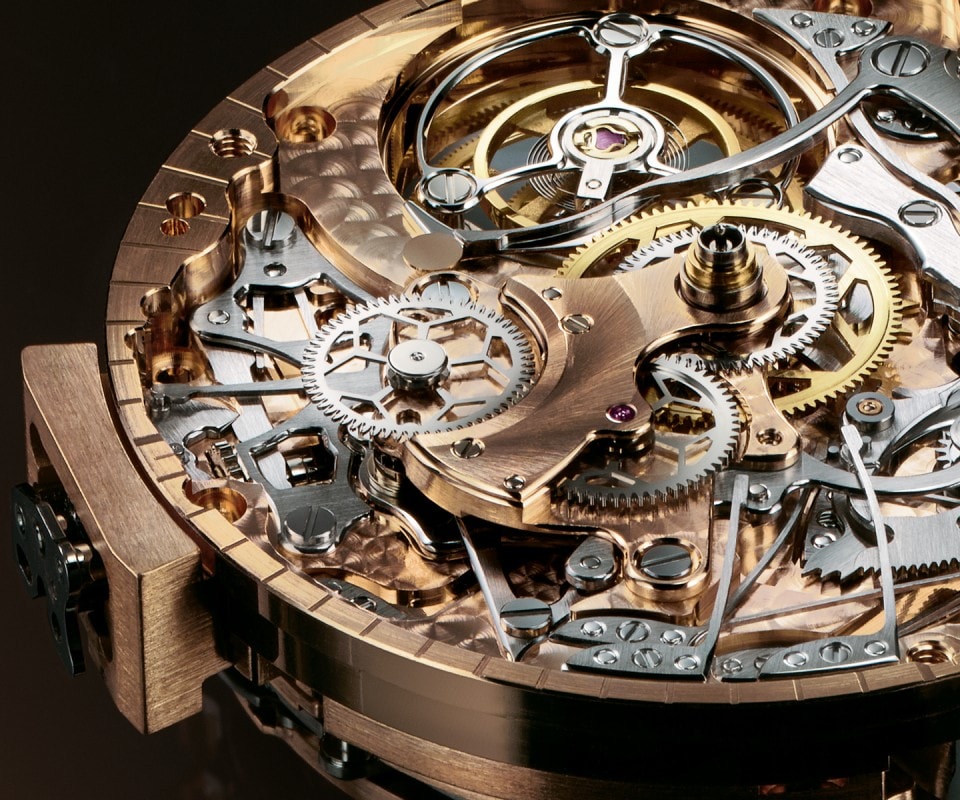
The dial side of the movement.
(hence the term “overcoil”), both centering and concentricity would be improved and along with that rate keeping of the watch. As it has done with several of its newest movements, Blancpain has constructed its balance spiral with a Breguet overcoil. The fabrication is painstaking as the upward and inward bend of each balance spiral is delicately fashioned by hand.
In adding a chronograph to the carrousel Blancpain achieved a world first as that combination has never been done before in a wristwatch. Indeed, because the chronograph incorporates a flyback function, meaning that instead of three pushes to command a stop, return to zero and restart for the chronograph, a single push of the lower button will suffice, the combination is a “double world first” in that a flyback has never before been combined with a carrousel in a wristwatch.
In the same way that the carrousel is heart of the grand complication’s timekeeping, the vertical clutch mechanism is the nerve center of the chronograph. Although Blancpain drew upon its nearly thirty years’ of experience in the construction of vertical clutch chronographs for this new grand complication, the design for the Le Brassus Carrousel Répétition Minutes Chronographe Flyback was evolved considerably. Throughout its collections, Blancpain’s chronographs have placed the minute counter for the chronograph in a subdial at the 3 o’clock position. A completely different architecture was sought for this first pairing of a chronograph and carrousel, one with a central large minute counter hand which would read upon the outer chapter ring of the watch dial. Much more was
involved than changing the gearing to move the indication from 3 o’clock to the center. Because the hand would be considerably longer than with a small subdial, the minute counter gear train was entirely redesigned. The minute counter hand is expected to move smartly to the next minute as the chronograph seconds hand passes 60. In order to ensure perfect motion without flutter or oscillation, Blancpain’s movement designers determined that a form of gear construction was required which differs from that which it has previously used in its chronographs. Instead of a classic solid tooth profile, the ideal answer was found with teeth that incorporate a “split.” The purpose of the “split” was to build into each tooth a form of shock absorber. These miniature shock absorbers not only produce a perfectly smooth advancement of the minute hand, they prevent unwanted wiggles if the watch is subjected to an external blow.
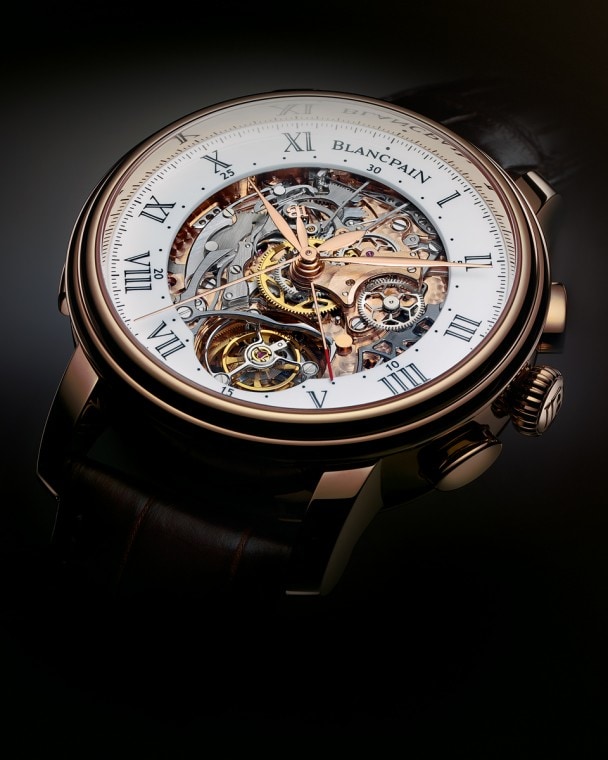
For the development of the chronograph, BLANCPAIN’S MOVEMENT DESIGNERS turned to cutting edge technologies.
The idea of shock absorption wheels was perfect; the method for producing them required a radical departure from old methods. Ordinarily, the teeth for gears (which watchmakers prefer calling “wheels”) are carved into the wheels with a milling cutter. From a high level perspective this is thought of as a subtractive process—material is cut away to produce the teeth. Although today’s subtractive processes for cutting teeth are staggeringly precise, they are insufficiently precise to form the type of split shock absorption teeth which Blancpain desired. Blancpain’s movement designers thereupon turned to methods oriented in a direction opposite from subtraction, namely, additive techniques. Instead of cutting away material from a disk to produce the teeth on a wheel, additive methods form the wheel, molecule-by-molecule, from the ground up. The wheel and its teeth are, thus, created together. Of course this calls into play leading edge technology. Although vastly more expensive than traditional cut teeth wheels, these additive wheels can be formed with tooth profiles far more complex and with greater precision than with subtractive cutting.
Blancpain has employed an additive process gear before in the X-Fathoms diving watch. As with the new grand complication, the demands of the X-Fathom’s mechanical depth gauge for a complex shape and extraordinary precision drove the decision to fabricate one of the key gears molecule-by-molecule.
There are two such high tech wheels in the Le Brassus Carrousel Répétition Minutes Chronographe Flyback, one located at 3 o’clock and the other at the center, both part of the chronograph’s minute counter gear train.
The shock absorber wheels guarantee perfect movement of the minute counter hand; it is the vertical clutch which produces perfect movement of the chronograph seconds hand. Except for some rare constructions that rely upon what is essentially a separate movement with a separate chronograph barrel, all chronographs employ some form of switching mechanism. The reason is intuitive. When the chronograph start is commanded, its gear train is “switched” or connected to the regular running train of the watch. Similarly, when a stop is commanded, the chronograph train is disconnected from the running train. Historically most haut de gamme chronographs utilized a horizontal clutch mechanism for this switching for start/stop. Unfortunately there are significant drawbacks to these designs which rely upon two gears suddenly coming together when the chronograph is started.

Ideally two gears should mate with the teeth of one falling into the troughs of the other. But as starting is a random event, the mating of the gears may not necessarily occur with teeth oriented toward troughs; sometimes a tooth will first contact another tooth. This causes an undesirable jump in the movement of the seconds hand. Further, to compensate for play in the engagement of teeth and troughs which would produce unwanted fluttering of the chronographs seconds hand as it circles the dial, a tension spring is employed with these designs. Although the tension spring helps smooth the movement of the hand, it adds drag to the running of the watch, changing the running rate when the chronograph is operating in comparison with its rate when it is not operating. Finally as the teeth of the wheels for these high grade chronographs are extremely fragile owing to their fine sharply triangular shape, to minimize wear, it is always advised to avoid running the chronograph constantly.
All of these drawbacks are cured with Blancpain’s vertical clutch design. Instead of relying upon the mating of two gears when the chronograph is started, two disks are pushed together. Starting takes place perfectly every single time with no jumping. Nor is there a need for a tension spring. The two plates rotate together with no risk of flutter. And with no need for a tension spring, there is essentially no change in the running rate of the watch when the chronograph is engaged. Finally by dispensing with fine triangular shaped gears that wear upon each other when engaged, the chronograph can be run constantly if the owner so desires. In short, Blancpain’s construction delivers the type of chronograph performance and operation that befits a true grand complication.
There was one more challenge associated with incorporating the chronograph within this new grand complication. As one of the complications is a minute repeater, its gongs (which are in the form of steel rings) encircle the movement. The standard placement of the chronograph pushers for start/stop and return to zero would cause their shafts to collide with the repeater’s gongs.
Figure A. The vertical clutch mechanism with the chronograph stopped; the two arms are holding the seconds hand disk away from contact with the bottom plate.
Figure B. The vertical clutch mechanism with the chronograph running; the two arms have been pulled away by the column wheel allowing the two plates of the clutch to come into contact with each other.
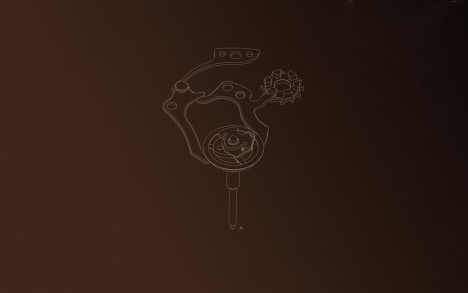

Framing the movement is a FULL FIRED ENAMEL dial.
So Blancpain had to develop a method to lower the shafts of the pushers so that they would pass below the encircling repeater gongs. This slight repositioning of the pushers, in turn, dictated a repositioning of the crown as well so that both pushers and crown would all be at the same height on the side of the case. Instead of a straight shaft running from the movement to the crown, there are two plates, one attached to the shaft from the movement and the second to the lowered crown and separate shaft to which it is attached. When the crown itself is pulled or turned, that motion is transferred via gears to the separate shaft in the movement. The two plates act as bearings for each of the two shafts.
From one perspective there is no such thing as a “standard minute repeater”. Producing crystal clear rich sound from a chiming mechanism is an artistic endeavor that can never be labeled “standard”. But beyond that, the minute repeater complication in this newest grand complication incorporates several innovations that set it apart from others in the industry.
Blancpain has long believed in secure movement constructions. By “secure,” Blancpain means that the movement will be protected against misuse by the owner. Of course, there is always the expedient of inserting warnings, usually in a large bold type face, in owner’s manuals, but Blancpain believes that a studied design delivers more genuine value and security than a written list of forbidden operations. In the case of a minute repeater the risk of misuse is the adjustment of the time while the repeater is sounding. Whereas others sternly instruct against such an adjustment, Blancpain goes further. When the repeater slide is pulled to initiate the chiming of the hours, quarter hours and minutes, the crown is disconnected from the movement. Thus, if the owner were to try and change the time setting, an action that would break the mechanism of other timepieces, nothing will happen; the crown will turn harmlessly.
There is a second important innovation which has been built into the Le Brassus Carrousel Répétition Minutes Chronographe Flyback, an extra-large repeater barrel. The energy for the sounding of all minute repeaters comes from the pulling of a slide on the side of the case.

The chronograph features two large hands, the red tipped hand for the minute counter, the longer hand for seconds.
This action winds a repeater barrel that powers the chiming. It has become standard practice in the industry that repeater barrels are wound for 1.5 turns when the slide is pulled. Unfortunately, for a long chime such as the one to sound the time 11:59 (which would require 11-hour strikes, 3 quarter-hour strikes — each of which consists of two strikes — and 14 minute strikes) the barrel is essentially exhausted for the final minute strike. As a result, the volume is generally lower and, in many cases, there may be a slowing of the chiming pace at the very end of the sounding. To address this problem, Blancpain has designed the repeater with an extra-large barrel which receives a full five turn wind when the slide is pulled. Instead of being completely unwound after 1.5 turns, the Blancpain barrel still stores 3.5 turns of energy during the final chimes. Both the volume and the pace are fully maintained even for the longest sounding, that of 11:59.
There is a third important dimension to the minute repeater: its gongs. The gongs (or if you like “rings”) of the Le Brassus Carrousel Répétition Minutes Chronographe Flyback repeater are extra-long; instead of circling the movement for one turn, they circle for one and half turns. This extra length, which confers the title “cathedral” upon the chiming, brings added richness and vibrancy to the sound. Of course, if the sound is not transmitted well from the movement to outside the case, all the design effort goes for naught. To enhance the transmission of sound, Blancpain has attached the cathedral gongs to the red gold walls of the case itself. This direct attachment significantly increases volume and clarity.
All of these innovations demand a worthy aesthetic package. To highlight the complexity of its sophisticated movement, the components of the Le Brassus Carrousel Répétition Minutes Chronographe Flyback are set upon a red gold stage, so to speak. Both the movement main plate and its bridges are fashioned in solid red gold. The bridges have been hand carved in Blancpain’s Le Brassus grand complication workshop. The decoration of the faces of the bridges requires a full day of hand work on each bridge. Of course, further patient work is required to bestow a hand filed anglage finish (using files and wooden burnishing tools) on the edges and even hand applied perlage to the hidden sides. All of the other components are equally decorated by hand, angled, brushed, and polished. The chapter ring dial is crafted in full fired enamel. And finally, as this is an automatic winding grand complication, the winding rotor is fashioned in 22 carat red gold.
A grand complication should be an emphatic expression of watchmaking art. Taken separately the complications of the Le Brassus Carrousel Répétition Minutes Chronographe Flyback—the flying carrousel, the flyback chronograph, the cathedral gong minute repeater—all lay claim to important horological advances. But the sum is greater than its individual parts. They have been integrated together into a single movement whose beauty and functionality transcends any individual element. Every owner can derive enormous pleasure in knowing this is a grand complication that has never been achieved before.
